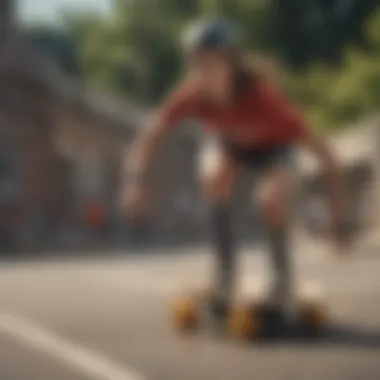Women Skateboarders: Pioneers of the Sport


Intro
The landscape of skateboarding has seen significant shifts over the past few decades. Traditionally dominated by male athletes, the rise of women in this sport is compelling. This surge is not merely about the increase in numbers but reflects a broader cultural change.
Women skateboarders are now breaking barriers, both in performance and perception. Their contributions include not only skillful tricks and techniques but also a push toward inclusivity and representation in a predominantly male domain.
The following sections will examine the crucial elements of this movement, from the gear that equips female skateboarders to the training techniques that enhance their abilities, as well as the safety measures and community dynamics involved in the world of extreme sports.
Equipment and Gear
Understanding the right equipment is essential for success in skateboarding. Women entering this sport must prioritize safety and performance through proper gear. Key items include:
- Skateboard: Choosing the right board can enhance performance. Brands like Element and Girl offer options focused on lighter materials and optimal maneuverability.
- Helmets: Protection is a priority. Brands such as Bell and Pro-Tec provide helmets that meet safety standards while ensuring comfort and style.
- Protective Gear: Knee pads and elbow pads are crucial for beginners to prevent injuries. Brands like Triple Eight offer high-quality equipment.
Tips on Maintenance
Regular maintenance of your skateboard and gear can extend their lifespan. Here are some essential tips:
- Keep the skateboard clean. Dust and debris can affect performance.
- Inspect the wheels for wear. Replacing worn wheels ensures better grip and stability.
Advancements in gear design also play a role in enhancing performance. Lightweight materials and innovative helmet designs are now more commonplace, making it easier for female skateboarders to focus on their skills while ensuring safety.
Techniques and Training
When considering advanced skills in skateboarding, women must focus on mastering foundational techniques first. Commonly practiced skills include:
- Ollies: A fundamental trick that enables other advanced maneuvers.
- Grinds: Sliding along an edge or rail can be challenging yet rewarding.
Training Exercises
Improving core strength and agility is crucial. Suggested routines include:
- Balance exercises on a skateboard.
- Core workouts using stability balls.
- Increasing agility with ladder drills.
Insights from seasoned athletes indicate that consistency in practice is vital for development. Many recommend recording sessions to analyze progress.
Safety and Risk Management
Safety cannot be overlooked in skateboarding. Establishing protocols is essential. Here are the main areas to focus on:
- Helmets and Protective Gear Usage: Always wear a helmet and pads when skating.
- Awareness of Surroundings: Choose safe locations with minimal obstacles and foot traffic.
Common Risks
While skateboarding can be exhilarating, the risks include:
- Falls: Injuries often stem from falls, particularly during trick attempts.
- Collisions: Awareness of surroundings can prevent crashes with other skaters or pedestrians.
Strategies such as practicing in less crowded areas and gradually increasing difficulty can help mitigate these risks.
Events and Competitions
The competitive scene for women skateboarders is expanding, with numerous championships drawing attention. Events like the X Games have started to include more female categories, showcasing elite talent.
- Upcoming Events: Keeping track of upcoming competitions is vital for athletes looking to gain exposure and experience.
- Profiles of Notable Competitors: Athletes like Leticia Bufoni and Poppy Star are setting examples and pushing boundaries in female skateboarding competitions.
Coverage of these events provides a platform for women in the sport, drawing attention to their skills and contributions.


Lifestyle and Community
Skateboarding promotes a unique lifestyle that blends athleticism with community. Meeting fellow enthusiasts fosters connection and support.
- Balancing Skateboarding and Life: Finding a balance between sport and other life aspects is crucial. Prioritizing mental well-being through relaxation and recovery enhances performance.
Community Engagement
Join online platforms or local skate clubs to interact with others in the sport. Resources such as Reddit or Facebook groups can provide support and information.
Engaging in the skateboarding community is essential for personal development and sport recognition.
In essence, women in skateboarding are making significant strides, shaping the future of the sport. It is crucial to support their journey through better representation and the sharing of their stories.
Prelims to Women in Skateboarding
Skateboarding is often viewed as a male-dominated sport, yet women have played a pivotal role in its history and continued evolution. The topic of women in skateboarding is essential for many reasons. First, it shines a light on the contributions and achievements of female skateboarders, who are often overlooked. Their stories are not just about participation; they reveal resilience, creativity, and determination against systemic barriers and stereotypes.
Exploring this subject offers insights into the changing landscape of extreme sports, where women are increasingly making waves as competitors, innovators, and community leaders. It also raises awareness of the need for inclusivity within the sport, an aspect that not only benefits women but enhances the sport as a whole. As skateboarding gains popularity globally, understanding the history and current standing of women within this realm becomes crucial to appreciating the full narrative of skateboarding culture.
Historical Context
The roots of women’s involvement in skateboarding can be traced back to the 1970s, a time when the sport was still in its infancy. Pioneers like Patti McGee emerged during this era, shattering stereotypes as they participated in competitive events. McGee’s presence laid the groundwork for future generations, showing that women could not only participate but excel in the sport. Initially, female skaters faced significant challenges, including a lack of representation and opportunities.
Daring to push against social norms, many women began to form clubs and collectives to support each other. The early years were marked by a struggle for recognition, yet the talent displayed by these skaters began to attract attention.
Current Landscape
In recent years, the landscape of women in skateboarding has transformed dramatically. Today, female skateboarders are not only competing in national and international events but are also gaining significant media coverage and sponsorship opportunities. Events like the X Games and the Olympics have incorporated competitions for women, which has elevated the visibility of female athletes in the sport.
The rise of social media has played a pivotal role in showcasing women's talents and fostering community. Platforms such as Instagram and TikTok allow female skateboarders to share their experiences, skills, and passion for skateboarding. As a result, there is a growing audience of young girls who see these athletes as role models, inspired to take up skateboarding themselves.
"The visibility of women in skateboarding is crucial. It inspires young girls to pursue their passion irrespective of societal expectations."
As female participation continues to evolve, it is evident that women are not just participants but influential figures shaping the future of skateboarding.
The Evolution of Women Skateboarders
The evolution of women skateboarders is a critical aspect of understanding the broader narrative of skateboarding as a sport. This topic highlights the significant transitions over the decades and the integration of women into a traditionally male-dominated world. It facilitates a deeper appreciation for the contributions made by female athletes and their enduring impact on the culture of skateboarding. Examining this evolution underscores the social dynamics that have prompted a change in perception regarding women in extreme sports.
From the early days of skateboarding, women often faced societal barriers that limited their participation. Initially, skateboarding was perceived as a male activity, fueled by physical prowess and risk-taking behavior. However, as more women began to challenge these norms, their presence reshaped the landscape of the sport.
Trailblazers in the Sport
Trailblazers have played an essential role in the history of women skateboarders. Individuals like Patti McGee and Laura Thornhill emerged during the 1970s, breaking through the restrictive norms of their era. Patti McGee, often credited as one of the first female competitive skateboarders, made her mark through exceptional skill and perseverance. She was featured in numerous skateboard magazines, thus increasing visibility for women in the sport.
These pioneers not only excelled on the board but also paved the way for future generations. They faced skepticism from both the public and male counterparts, yet their dedication prompted a shift in attitudes. These women’s contributions are foundational; they transformed the perception of female athletes from being mere spectators to sport participants on equal footing with men.
Modern Icons
Today, modern icons exemplify the continued evolution and emergence of women in skateboarding. Athletes like Lizzie Armanto and Aori Nishimura gained prominence in recent years, showcasing talent that compels visibility and respect for female skateboarders globally. Lizzie Armanto, known for her technical skills and creativity, represents a new wave of female talent in competitive skateboarding. Her achievements reflect not just personal triumph but also broad societal acceptance of women in extreme sports.
Moreover, Aori Nishimura stands out as a youth icon in skateboarding, particularly noted for her performances in various international competitions. As these athletes gain sponsorships and mainstream media attention, they inspire a new generation of girls to engage with skateboarding.
In summary, the evolution of women skateboarders not only highlights trailblazers and modern icons but also emphasizes the ongoing shift in cultural attitudes. The journey of these athletes illuminates the challenges overcome and sets the tone for future female skateboarders, reinforcing the need for continued support and representation in the sport.
Challenges and Barriers
The journey of women in skateboarding is marked by various challenges and barriers. These obstacles not only hinder participation but also affect the overall perception of female skateboarders. It is crucial to address these issues to foster a more inclusive environment in a sport traditionally dominated by men. Understanding challenges faced by female skateboarders helps in formulating actionable strategies that promote equality and representation.


Stereotypes and Misconceptions
Stereotypes about gender roles often permeate the skateboarding culture. Women are sometimes viewed as less capable or serious about extreme sports, leading to misconceptions that undermine their achievements. This perception affects young girls who might want to start skateboarding. They may be dissuaded by doubt about their capabilities or fear of judgment from the community. As noted in several studies, a significant number of girls state that societal perceptions about femininity discourage them from participating in various sports, including skateboarding.
Addressing these stereotypes is essential. Skateboarding brands and organizations can play an important role by highlighting female skateboarders. Using media to showcase their skills and successes may shift the narrative. Education about these misconceptions is necessary to build a supportive community where all skateboarders feel valued.
Accessibility and Inclusivity
Accessibility challenges also play a significant role in the barriers faced by women in skateboarding. Skate parks and training locations are not always designed with inclusivity in mind. Many facilities lack adequate space and resources for women. Often, these areas may feel unsafe or unwelcoming for young girls and women. When spaces do not encourage participation, it results in decreased interest and engagement.
Furthermore, the cost of skateboarding gear can be prohibitive. This expense can limit access, particularly for lower-income families. Sponsorship and financial support for women in skateboarding can greatly increase participation. Initiatives focused on creating accessible skate parks and providing free or affordable resources can help bridge the gap in inclusivity.
Impact of Skateboarding Organizations
Skateboarding organizations play a profound role in shaping the landscape of the sport, especially in the inclusion and support of women skateboarders. These organizations help create opportunities for female athletes, encouraging them not just to participate, but to excel in various levels of competition. They set standards, promote events, and provide resources that are vital for growth within the sport.
Role of Professional Skateboarding Leagues
Professional skateboarding leagues have become central to the advancement of women in skateboarding. They offer structured competitions where female skateboarders can showcase their skills and compete at a high level. Events organized by leagues such as the World Skate League have become platforms for women athletes to gain visibility and professional recognition.
Moreover, these leagues are essential for gaining sponsorships and media coverage, providing female skateboarders more opportunities to reach a wider audience. The professionalization of women's skateboarding reflects a commitment to equality and representation in what was predominantly a male-dominated environment. The recent inclusion of women's events in major competitions further illustrates this shift.
Support from Sponsorships and Brands
Support from brands and sponsorships is equally important. Many companies are beginning to recognize the value of investing in female athletes to diversify their marketing strategies. This not only helps in commercializing women’s skateboarding but also elevates the athletes' profile. Brands like Nike, Vans, and Element have made significant efforts to promote female skateboarders, realizing that their participation inspires future generations.
Funding from sponsorships enables female skateboarders to access better training facilities, coaching, and equipment. It also helps cover travel expenses for competitions, allowing athletes to compete internationally. The direct outcome is an increase in participation rates among women who see role models thriving in the sport.
"Support from brands is not just financial; it's a commitment to elevating women in skateboarding, breaking barriers, and inspiring younger girls to pick up a skateboard."
Cultural Shifts and Advocacy
Cultural shifts and advocacy play a crucial role in the ongoing transformation of women’s involvement in skateboarding. This shift is not just a trend; it represents a fundamental change in societal attitudes and perceptions towards female athletes in extreme sports. Understanding these changes helps in recognizing the factors that contribute to increasing participation by women in skateboarding.
Rising Female Representation
In recent years, there has been a noticeable increase in the representation of female skateboarders. Events such as the X Games and the Olympics have introduced more competitions specifically for women. This visibility encourages young girls to take up the sport.
- Female athletes are beginning to take up space in skate parks, inspiring others around them.
- Increased representation in competitions leads to more media coverage, showcasing female talent.
- Positive role models like Leticia Bufoni or Aori Nishimura inspire future generations.
This rising representation not only showcases talent but also shifts public perception. More brands are sponsoring female skateboarders, which further validates their contribution to the sport. Each representation victory creates a cycle that can draw more young girls into skateboarding, fostering a larger and more diverse community.
Social Media and Community Building
Social media platforms like Instagram and TikTok serve as powerful tools for female skateboarders to connect, share, and support one another. Online communities have emerged where women can showcase their skills, share tips, and advocate for gender equality in the sport.
- Social media allows for the dissemination of content highlighting female athletes, their skills, and their stories.
- Online tutorials and challenges have expanded accessibility to skateboarding.
- Communities like Girls Skate Network support and uplift women in the sport across different regions.
Social media has created a space for networking that was previously difficult to find. Women can find mentorship, share their challenges, and celebrate their victories together. This sense of community not only contributes to personal growth but also drives collective advocacy for equal opportunities in skateboarding.
"Representation matters. When women see other women thriving, they believe they can too."
Profiles of Notable Female Skateboarders
The exploration of prominent female skateboarders is crucial for understanding the progress of women in this sport. These profiles highlight both the achievements and the struggles faced by female athletes. By showcasing their stories, we not only honor their contributions but also inspire future generations. Recognizing these pioneers emphasizes the critical role of representation in skateboarding, a sport that has been historically male-dominated. Their influence extends beyond skateboarding; they challenge social norms and stereotypes related to women in sports.
Pioneer Figures
Pioneering female skateboarders forged paths that set the foundation for future athletes. One of the most notable figures is Pamela "Pam" McCullough, who became famous in the 1970s for her impressive skateboarding skills and ability to defy societal expectations. During that time, she regularly competed against men, demonstrating that women could not only participate but excel in extreme sports.


Another influential skater is Elissa Steamer, widely regarded as the first female skateboarder to achieve worldwide recognition. Steamer's fearlessness and unique style captured the hearts of many. Her participation in contests alongside male athletes helped break barriers, making her a role model for young female skaters.
Karen "K-Rob" Roberts is also vital to recognize. With her groundbreaking achievements in vert skating, Roberts shone a spotlight on female talent in a sport often overlooked by the mainstream. She won multiple championships, paving the way for other women in the sport and inspiring them to pursue their dreams.
Every one of these women has made historical impacts within skateboarding, but their influence goes beyond the accolades. They have instilled a sense of possibilities in aspiring female skateboarders worldwide.
Current Champions
Today, women's skateboarding continues to thrive, thanks in part to the current champions who keep pushing the boundaries. Sky Brown, a teenage sensation, has already made headlines, winning prestigious competitions like the X Games. At a young age, she has shown immense talent and potential, becoming a symbol of hope for the next generation of girls in skateboarding.
Another prominent figure is Lacey Baker, known for her technical skills and fierce competitive spirit. Baker's advocacy for equal pay and opportunities for female skateboarders has brought attention to ongoing issues within the sport. Her determination and voice are vital elements of the drive for greater inclusion.
Nicole Hause is also making strides. With her creative and innovative style, she has captured the attention of the skateboarding community. Hause's performances reflect a blend of athleticism and artistry that resonates with many fans, contributing to the rising visibility of female skateboarders.
These athletes are not only excelling in competitions but also actively representing the new wave of female talent. Their presence in the global scene is significant for encouraging inclusivity and expanding opportunities in skateboarding. Each of these champions contributes to a broader narrative — one that showcases the growth and acceptance of women in this thrilling sport.
"The stories and achievements of these women demonstrate that skateboarding knows no gender. As we recognize their contributions, we also inspire the young girls watching today to believe in their own potential."
Through the lens of their experiences, we can see the evolution of female skateboarders. These profiles reflect a powerful narrative and underscore the importance of supporting women in skateboarding.
The Future of Women in Skateboarding
The future of women in skateboarding is a topic of extensive importance and relevance. This segment seeks to clarify how upcoming developments can reshape the landscape of the sport. As skateboarding continues to gain traction on a global scale, various elements play a crucial role in determining how female participation evolves. Significant attention is required regarding support mechanisms, community engagement, and the establishment of more inclusive platforms. These considerations will not only facilitate growth but also inspire future generations of female skateboarders.
Opportunities for Development
Female skateboarders have numerous opportunities for development. First, skateboarding organizations are making strides by creating female-specific events. These competitions encourage participation by providing a welcoming atmosphere. Initiatives like the Women's Skateboarding Alliance aim to cultivate talent through mentorship programs, workshops, and competitions tailored specifically for women.
Additionally, educational campaigns can be beneficial. By promoting skateboarding in schools and colleges, institutions can attract young female athletes early on. Greater visibility of successful female skateboarders in mainstream media and social networks also plays a role. When young girls see role models in the sport, they are more likely to become involved.
Investment in community skate parks is another critical area. Public parks equipped with women-friendly designs promote safety and comfort. Better facilities encourage skills development and confidence. On a grassroots level, local skate shops can offer classes or events exclusively for women, fostering a sense of belonging and community.
Potential for Growth in Diversity
The potential for growth in diversity within skateboarding is substantial. As societies move towards inclusivity, the sport can reflect these changes. It is essential to broaden the appeal of skateboarding not just to diverse genders but also to various cultural and socio-economic backgrounds.
Programs focusing on underrepresented communities can result in a more vibrant skater culture. Collaborations with organizations assisting marginalized groups can expand reach. Sponsorships by major brands that prioritize diversity can further bolster this growth. When companies recognize and support a diverse range of athletes, they not only enhance their brand reputation but also contribute to a more inclusive future.
Moreover, the rise of social media platforms offers unique opportunities. It allows female skateboarders from different backgrounds to connect and share their experiences. Platforms like Reddit and Facebook are becoming vital for community building, giving voices to various stories and backgrounds in the sport.
"A diverse range of participants leads to richer narratives and greater innovation inside the sport."
The End: A Call to Action
The conclusion of this article serves as a reminder that the progress of women in skateboarding is still a work in progress. As society becomes increasingly aware of the importance of representation, it is essential to recognize the unique challenges female skateboarders face. Issues such as funding, visibility, and community support must be addressed to create a more inclusive environment in this sport. By calling for action, we encourage stakeholders to commit to fostering all female talent in skateboarding, ensuring that young girls see themselves represented in high-performance skateboarding venues.
- Support Female Talent: There is a pressing need for increased support for female athletes through funding and sponsorships. Brands in the skateboarding industry should prioritize partnerships with female skateboarders. This approach would not only empower athletes but also provide them with the resources needed to compete at high levels.
- Promote Inclusivity: Events should aim to be as inclusive as possible, providing equal opportunity for women to participate in competitions. An emphasis on women’s categories in tournaments can help in showcasing their talents and inspire the next generation of skateboarders.
- Educational Initiatives: Educational programs focusing on techniques, safety, and competitor preparation can facilitate growth amongst female skateboarders. Skateboarding should not be viewed solely as a male-dominated activity. Programs aimed at young girls can cultivate an encouraging atmosphere, promoting skill advancement and helping to break stereotypes linked to extreme sports.
"The more we support and elevate women in skateboarding, the more diverse and inspiring the culture will become."
Increasing Support for Female Athletes
To increase support for female athletes in skateboarding, various strategies should be implemented. Firstly, there is a need for sponsorship from existing skateboarding brands. When companies like Vans and Nike invest in female athletes, it sends a strong message that women belong in the sport. Additionally, creating scholarships could provide access to skateparks and training for those who may not have financial means.
Moreover, media exposure plays a crucial role. By highlighting female skateboarders in mainstream and niche publications, their achievements gain visibility. This exposure helps to challenge the current narrative that skateboarding is primarily a male pursuit. Enhanced media presence could ultimately lead to more girls feeling motivated to take up skateboarding.
Lastly, mentorship programs where established female athletes connect with newcomers can be invaluable. Such initiatives foster relationships within the community, creating networks of support that uplift learners while celebrating their individual journeys.
The Role of the Community in Fostering Inclusion
Community plays a vital role in promoting inclusion in skateboarding. Local skate parks can become hubs for female athletes, creating safe spaces for training and events. Building a welcoming atmosphere encourages girls to participate without the fear of judgment.
Grassroots organizations focusing on urban skate culture can create workshops specifically targeting young girls. Events designed with their needs and interests in mind can facilitate engagement and build confidence in their abilities.
Engaging male skateboarders as allies is also crucial. By fostering a respectful environment and promoting equality, they can help dismantle stereotypes that deter women from the sport. When male skateboarders advocate for their female counterparts, it promotes unity within the community.















